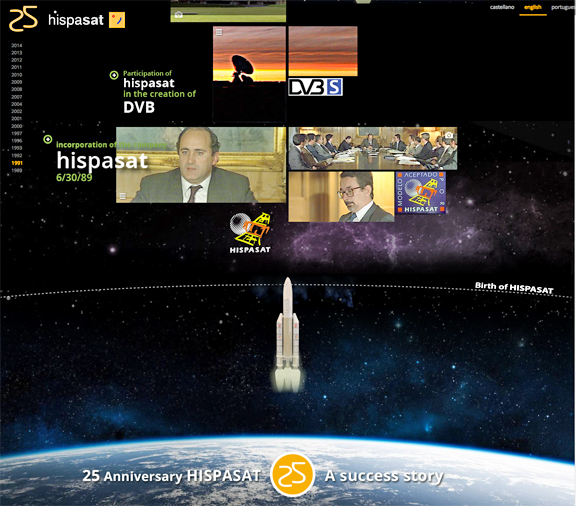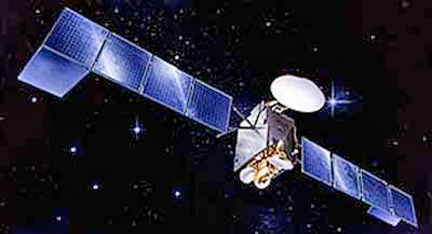
[SatNews] Spanish satellite telecommunications operator, HISPASAT, celebrated its 25th anniversary on October 22nd, with a concert held at the Royal Theatre in Madrid.
The event was presided by His Majesty the King and the Spanish Minister of Industry, José Manuel Soria was also present. Other renowned members of the Spanish government attended as well, alongside top managers from the aerospace, telecommunications and television industries.
In her speech, the president of HISPASAT, Elena Pisonero, said that the company was born “from a shared dream” to “achieve independent space communication” and drive a project “that would propel the national space industry. We should feel genuinely proud of achieving this dream”, she said, while thanking “the team of highly-qualified professionals, who made it possible” for their “hard work and effort.” Indeed, Pisonero pointed out that the bid for Brazil, which began to take shape in 2001, was “the most important business decisions” the company had ever made, since it “created a foothold for expansion across the Atlantic” where today, over half of the Company’s income is generated.
“Nowadays, the keys to growth and to conquering the market are somewhat different”, said the HISPASAT president, claiming the secret lies in “the revolution of the internet, the boom of social networks and the digital restructuring of all activities and business pursuits. Our challenge is to provide our clients with highly valuable solutions”, she added, “so that these solutions can then reach all members of society”.
Indeed, Pisonero confirmed she was aware “that the core activities of our Company form part of the high-power, far-reaching modern telecommunications infrastructure available today. However, we continue to work towards bringing this infrastructure closer to the heart of the digital transformation. We have embarked on significant development projects” she said, mentioning high definition television, satellite television services being delivered to all household devices and internet access solutions for rural areas in Latin America and Europe, to name but a few."
The HISPASAT president also spoke about the new growth and expansion stage the operator is now entering into, which includes “the firm support of our majority shareholder, Abertis, dedicated to backing this ambition."
25 years’ worth of effort rewarded

Artistic rendition of the HISPASAT-1A satellite.
HISPASAT was founded on the June 30, 1989, given the Spanish government’s interest in gaining independence in the satellite telecommunications field, through a company which would meanwhile serve to drive the national aerospace industry. The Hispasat 1A and 1B, the first HISPASAT satellites to be built, located at 30 degrees West, made it possible to send RTVE (The Spanish Radio and Television Corporation) broadcasts to America, from New York to the Land of Fire. This later gave rise to the operator entering the Latin American market.
This trend was reinforced through the acquisition of new orbital rights at 61 degrees West, where HISPASAT’s fleet of Amazonas satellites were later located in 2000, with HISPAMAR, its Brazilian subsidiary, being founded in 2001. HISPASAT then began to internationalize, which led it to become a regional reference operator in the booming Latin American market. As a result, HISPASAT has continued to grow over the past few years, despite the economic crisis and shrinking European markets. Indeed, in 2013, 55.6 percent of the company’s income was generated through renting space capacity from America, while the remaining 44.4 percent came from the European and North African markets.
HISPASAT is currently the ninth highest ranking satellite telecommunications operator in the world. It has satellites in four orbital positions and seven satellites in orbit, with a further three currently being built. This positive evolution backed by Abertis as its majority shareholder since late 2013 means HISPASAT is currently immersed in a new growth and expansion process, aiming to convert the Group into a global player in the satellite communications sector. Investment in new satellite programs has therefore increased, with the aim of doubling the size of the fleet from five satellites to ten, between 2012 and 2016. The company is currently seeking new orbital positions through formal bidding and award processes and partnerships with other operators, such as the agreement reached with Intelsat to jointly operate at 55.5 degrees west. They are furthermore looking into inorganic growth opportunities, which will make it possible to expand the Group’s coverage and offer. Likewise, HISPASAT’s vocation continues to drive the Spanish aerospace industry, having generated 1,000 million Euros in industrial profit for Spanish companies in the sector over the past 25 years.
Indeed, throughout these 25 years, HISPASAT has also paid special attention to innovation, directed at both improving satellites technologically and developing new, better services for its clients, which provide an accurate response to new market demands. The Spanish operator is therefore working on several research, development and innovation projects in the service sector, researching compression technology, home and mobile connectivity developments and new network architectures, which will make it possible to make satellite communications more useful and efficient. Indeed, HISPASAT has led innovative developments in the Ultra High Definition television industry, amongst which its open satellite channel “Hispasat 4K” stands out for having made this technology available to the industry, thereby facilitating its more rapid deployment.
To celebrate this anniversary, the operator launched a website (http://www.hispasat.com/hispasat25/index_en.html) which gives a chronological tour of the Company’s most relevant milestones since it was founded and will soon announce new activities related to its anniversary.
The HISPASAT infosite may be reached at http://www.hispasat.com/

